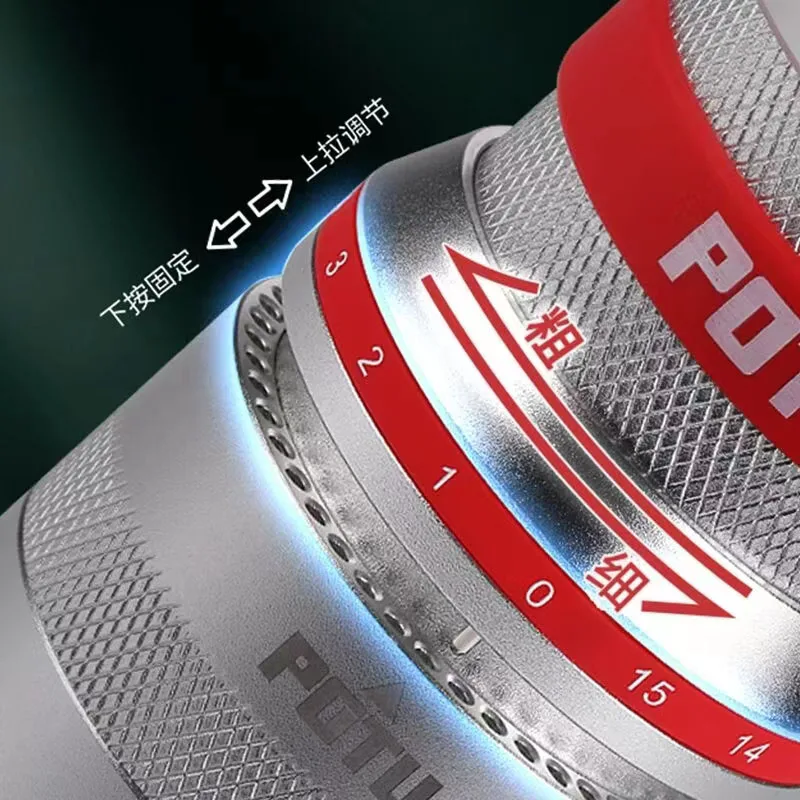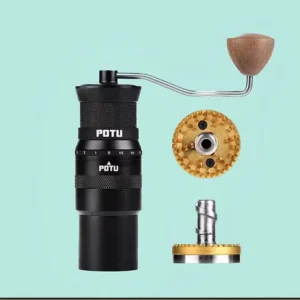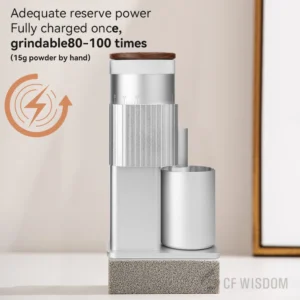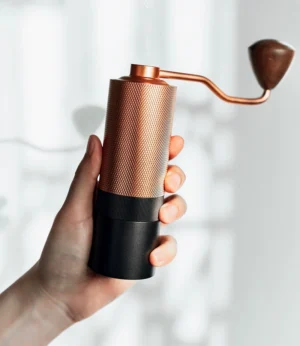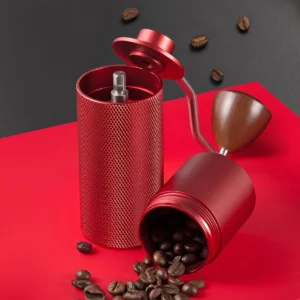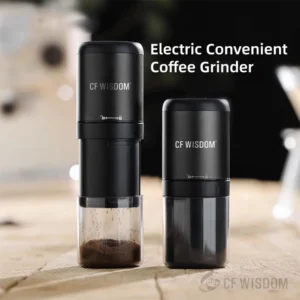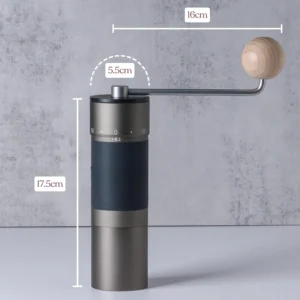Mastering the Perfect Grind: The Foundation of Great Espresso
The journey to creating exceptional espresso begins long before you press that first drop of water through your manual espresso maker. In the hierarchy of factors that influence your final cup, grind quality stands firmly at the top. This isn’t merely important—it’s absolutely fundamental.
When brewing with a manual espresso maker, the grind becomes even more critical than with other brewing methods. The pressurized extraction process demands precision that simply isn’t required for drip or French press brewing. Get the grind wrong, and even the most expensive beans from the most exclusive farms will yield disappointing results.
But here’s the good news: master your precision grind settings for espresso, and you can transform even moderately priced beans into something extraordinary. Throughout this guide, you’ll discover how to achieve the perfect consistency, make precise adjustments to your grinder, and troubleshoot common problems that stem from improper grinding.
The difference between mediocre and magnificent espresso often comes down to just fractions of a millimeter in grind size—a level of precision that reveals the true art behind the science of espresso.
Understanding Espresso Extraction: Why Grind Size is Critical
To truly master espresso grinding, we need to understand what happens during extraction. When pressurized water meets coffee grounds, it doesn’t simply wash over them—it engages in a complex dance of chemistry and physics.
Coffee grounds are not solid particles but porous structures. The smaller these particles (finer grind), the more surface area is exposed to water, allowing for faster extraction of compounds. Conversely, larger particles (coarser grind) have less surface area, slowing extraction significantly. This relationship between particle size and extraction rate is at the heart of espresso brewing.
When your grind is too coarse, water rushes through too quickly, resulting in under-extraction. Your espresso will taste sour, thin, and disappointingly flat because the water hasn’t had sufficient contact time to extract the full range of desirable compounds. On the flip side, grinding too fine causes over-extraction as water struggles to pass through. The result? Bitter, astringent espresso that masks the bean’s natural characteristics.
Understanding how grind size affects espresso extraction isn’t just technical knowledge—it’s the key to unlocking your manual espresso maker’s full potential. The ideal extraction balances acids, sweetness, and body in perfect harmony, creating that elusive, velvety texture espresso lovers chase.
The Ideal Espresso Grind: Visual and Tactile Identification
Identifying the perfect espresso grind involves both sight and touch. Visually, ideal espresso grounds should resemble fine granulated sugar, perhaps slightly finer. Unlike table salt crystals, which have a distinct size you can easily see, proper espresso grounds appear more like a cohesive mass of tiny particles.
When you touch properly ground espresso coffee between your fingertips, it should feel fine and somewhat powdery, but not completely like flour or powdered sugar. There should be a slight grittiness—imagine the texture of very fine sand. The grounds should clump slightly when pressed together but still break apart easily.
Warning signs of incorrect grinding include:
– Obvious unevenness in particle size
– Excessive clumping that forms dense balls (often too fine)
– Grounds that look like small pebbles (too coarse)
– A powdery texture that feels like talcum powder (potentially too fine)
Developing this sensory awareness of ideal espresso grind texture takes practice but becomes intuitive over time. Taking photos of your successful grinds can create a visual reference library to guide future brewing sessions. Remember that the perfect espresso grind exists within a narrow range, and finding it is both a science and an art.
Essential Equipment: Choosing the Right Grinder for Manual Espresso
Not all coffee grinders are created equal, and this becomes painfully obvious when brewing espresso. The equipment you choose significantly impacts your ability to achieve the consistent, fine grind necessary for proper extraction.
Blade grinders, while inexpensive and widely available, are fundamentally incapable of producing the uniform particle size required for espresso. Their chopping action creates a mix of fine powder and larger chunks, leading to uneven extraction. For espresso, they simply won’t do.
Burr grinders represent the only viable option for espresso enthusiasts. These grinders crush beans between two surfaces (burrs) rather than chopping them, resulting in much more consistent particle size. Burr grinders come in two main varieties:
- Flat burr grinders: Feature two parallel rings that crush beans uniformly, often producing very consistent grounds ideal for espresso
- Conical burr grinders: Use a cone-shaped burr fitting inside another, creating a more versatile grinder that can still achieve espresso fineness
Understanding why burr grinders are essential for espresso preparation can save you considerable frustration. When shopping for an espresso-capable grinder, prioritize features like:
- Stepless adjustment (or very small step increments)
- Quality burrs made of ceramic or hardened steel
- Minimal grind retention to prevent stale grounds mixing with fresh
- Stability and durability to maintain consistent settings
Our manual coffee grinders for espresso collection features options specifically engineered to meet these requirements, ensuring your brewing journey starts with the right foundation.
Manual Burr Grinders: Pros and Cons for Espresso
Manual burr grinders have seen a renaissance among espresso enthusiasts, and for good reason. These hand-operated tools offer several distinct advantages for the dedicated espresso brewer:
Advantages:
– Exceptional precision, often with more adjustment points than electric counterparts
– No motor means no heat generation during grinding (heat can damage flavor compounds)
– Physical connection to the grinding process provides tactile feedback
– Portability for travel or outdoor brewing
– Often more affordable than electric grinders of comparable quality
Disadvantages:
– Requires physical effort, especially for espresso’s fine grind
– Time-consuming when preparing multiple shots
– Consistency can be challenging to maintain throughout longer grinding sessions
– Limited capacity compared to electric models
When selecting a manual grinder for espresso, look for models with stabilized burrs (to prevent wobbling), fine adjustment capabilities, and comfortable ergonomics. The best manual grinders feature precision-engineered burrs specifically designed for achieving espresso-level fineness.
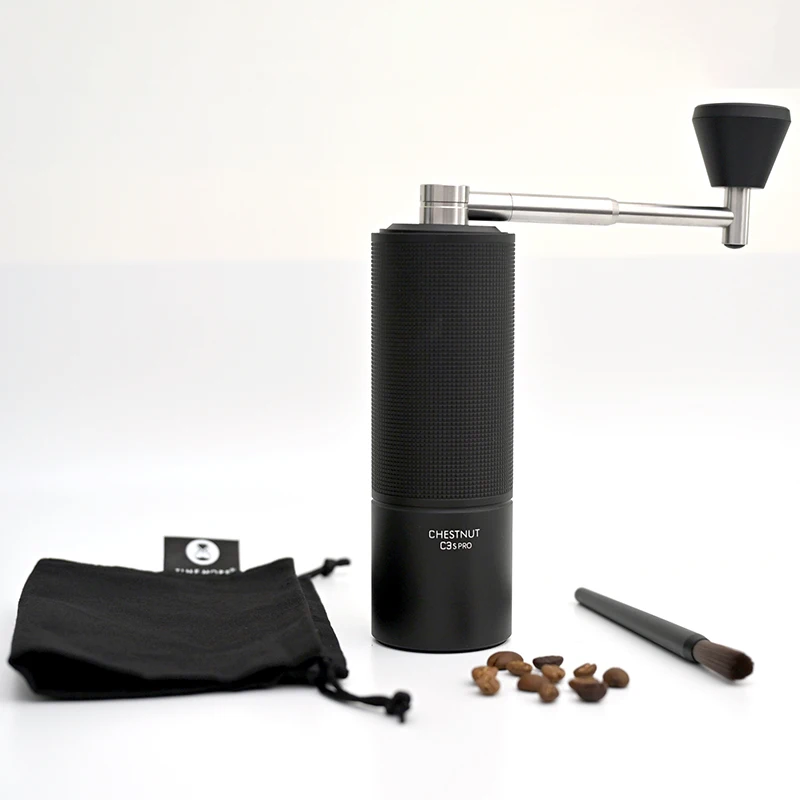
Our precision manual grinder selection addresses these requirements with models designed specifically for achieving the consistent fine grind espresso demands.
Electric Burr Grinders: Essential Features for Espresso
Electric burr grinders offer convenience and consistency that manual options sometimes can’t match, especially for daily use or when preparing multiple shots. However, not all electric burr grinders are suitable for espresso. Here are the critical features that separate espresso-capable electric grinders from the rest:
Stepless Adjustment: Unlike stepped grinders that click between preset positions, stepless models allow infinitely small adjustments. This precision is crucial for dialing in espresso, where tiny changes make significant differences.
Burr Quality and Design: Commercial-grade burrs made from hardened steel or ceramic provide the durability and precision needed for consistent espresso grinding. Flat burrs often produce more uniform particle size, while conical burrs may generate fewer fines.
Minimal Retention: Grounds that remain trapped in the grinder between uses can stale and contaminate fresh batches. Quality espresso grinders minimize this retention with designs that let grounds flow cleanly through the mechanism.
Heat Management: Motors generate heat that can transfer to burrs and beans, potentially affecting flavor. Better espresso grinders incorporate thermal protection or operate at lower RPMs to mitigate this issue.
Maintenance becomes particularly important with electric grinders for espresso. Regular cleaning prevents oil buildup that can affect grind consistency and flavor. Look for models with easy access to the burr chamber for cleaning.
Step-by-Step Guide to Grinding Coffee for Manual Espresso Makers
Follow this methodical approach to achieve consistent, high-quality grounds for your manual espresso maker:
Measure precisely: Begin by weighing your beans, typically 14-18 grams for a double shot. Volume measurements are simply not accurate enough for espresso.
Check your grinder: Ensure the grinder is clean and free of old grounds that could contaminate your fresh batch.
Select initial grind setting: If your grinder has numbered settings, start at the finer end of the espresso range. With stepless grinders, begin with a setting that produces powder-like grounds with slight texture.
Consistent technique: For manual grinders, maintain steady pressure and speed throughout the grinding process. With electric grinders, use the portafilter attachment if available or grind into a separate container.
Observe the grounds: Look for consistency in particle size—the grounds should appear uniform without obvious chunks or powder.
Perform the pinch test: Take a small amount between your fingers and press. It should clump slightly but still break apart when disturbed.
Adjust as needed: After your first extraction, be prepared to make adjustments based on flow rate and taste.
Learning to adjust your espresso grind is an iterative process that improves with experience. Document your settings and results to build a personal reference guide that accounts for your specific equipment and preferences.
Dialing In Your Espresso: Grind Adjustment Techniques
Dialing in refers to the process of fine-tuning your grind size to achieve optimal extraction with your specific beans and equipment. This skill separates casual espresso makers from those who consistently produce exceptional shots.
Start with a baseline grind that allows extraction to complete in approximately 25-30 seconds for a double shot (when using 14-18 grams of coffee). From this starting point, make incremental adjustments based on what you observe:
If your shot extracts too quickly (under 20 seconds), the grind is too coarse. The resulting espresso will likely taste sour, thin, and lacking complexity. Make your grind finer by a small increment.
If your shot extracts too slowly (over 35 seconds) or barely drips, the grind is too fine. This over-extracted coffee will taste bitter and harsh. Adjust slightly coarser.
The critical rule for dialing in: make one small adjustment at a time. Dramatic changes make it impossible to gauge cause and effect accurately. Patience yields precision.
Visual cues are equally important. Look for:
– Even flow from both spouts (if using a split portafilter)
– A steady stream with the consistency of warm honey
– Rich, tiger-striped crema
Reference our ultimate espresso grind size chart for visual comparisons that help identify where your current grind falls on the spectrum. Remember that different beans may require different settings, even with the same roast level.
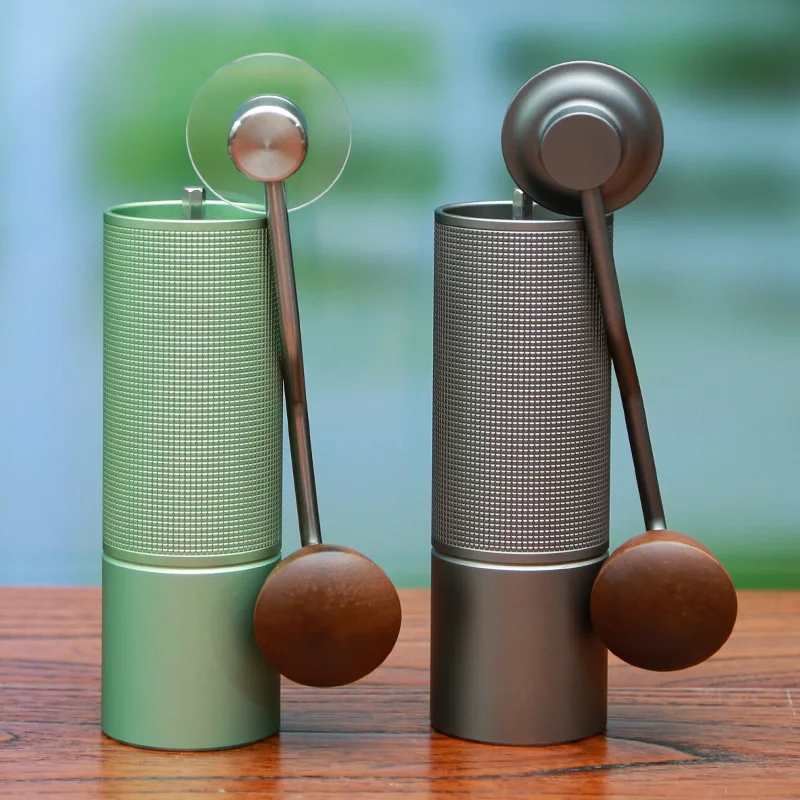
Common Grind-Related Problems and Solutions
Even experienced baristas encounter grinding challenges. Here’s how to diagnose and solve the most common issues:
Problem: Fast Shot/Sour Taste (Under-extraction)
– Symptoms: Shot completes in under 20 seconds, tastes sharp, sour, or lacks body
– Solution: Make your grind finer in small increments until extraction time extends to 25-30 seconds
– Additional Fix: Ensure proper distribution of grounds in the portafilter to prevent channeling
Problem: Slow/Dripping Shot/Bitter Taste (Over-extraction)
– Symptoms: Shot takes over 35 seconds or barely drips; tastes intensely bitter or ashy
– Solution: Adjust grind slightly coarser until flow normalizes
– Additional Fix: Check that you’re not tamping too hard, which can compound flow issues
Problem: Uneven Extraction/Channeling
– Symptoms: Extraction starts from different parts of the portafilter at different times; shot tastes simultaneously sour and bitter
– Solution: Focus on grind consistency and proper distribution technique
– Additional Fix: Consider a distribution tool to ensure even coffee bed before tamping
Problem: Static and Clumping
– Symptoms: Grounds stick to grinder components or form annoying clumps
– Solution: Try the Ross Droplet Technique (adding a drop of water to beans before grinding)
– Additional Fix: Some grinders benefit from periodic cleaning to remove oils that contribute to static
Our fine adjustment hand grinders are specifically designed to help eliminate many of these common problems through precision engineering and consistent grinding mechanisms.
Consistency Factors Beyond Grind Size
While grind size receives most of the attention, several complementary factors significantly impact extraction consistency:
Bean Freshness: As coffee ages, it releases carbon dioxide and undergoes chemical changes that affect extraction. Generally, espresso beans perform best between 7-21 days after roasting. Very fresh beans (1-6 days) may cause inconsistent extraction due to excessive gas release.
Distribution Technique: After grinding, how you distribute coffee in the portafilter dramatically affects extraction uniformity. Uneven distribution leads to channeling—water finding the path of least resistance through your coffee puck. Consider techniques like:
– Gentle side-tapping to settle grounds
– North-south-east-west distribution with a finger
– Using a distribution tool for perfect evenness
Tamping Pressure: Apply consistent pressure (about 30 pounds) perpendicular to the coffee bed. Inconsistent tamping leads to uneven resistance to water flow. The exact pressure matters less than consistency between shots.
Temperature Stability: Both your grinder and espresso maker benefit from temperature consistency. Allow your equipment to reach thermal equilibrium before brewing serious shots. This often means running a blank shot or grinding a small amount of coffee that you discard.
Our manual espresso grinders are designed with these consistency factors in mind, offering features that promote uniform grinding regardless of environmental conditions.
Maintaining Your Grinder for Optimal Espresso
A well-maintained grinder delivers consistent results year after year. Establish these maintenance habits to ensure your equipment performs at its best:
Daily Cleaning: After each use, brush out the grinding chamber and chute to remove coffee particles that can go stale and affect future shots. For manual grinders, disassemble as recommended by the manufacturer to remove grounds from threads and chambers.
Deep Cleaning Schedule: Every 1-2 weeks (depending on usage), perform a more thorough cleaning:
– Remove accessible burrs according to manufacturer instructions
– Clean burrs with a soft brush (never water for most burrs)
– Remove coffee oils with grinder cleaning tablets or uncooked rice (for some models)
– Reassemble carefully, ensuring proper alignment
Calibration Checks: Periodically verify that your grinder maintains its calibration:
– Does the zero point (burrs touching) remain consistent?
– Are adjustment mechanisms moving smoothly?
– Is there any unusual noise during operation?
Burr Replacement: Even high-quality burrs eventually wear down. Signs include:
– Increasing difficulty achieving fine enough grinds
– More fines and inconsistent particle size
– Unusual sounds during grinding
Learning proper cleaning techniques for manual coffee grinders extends their lifespan and ensures consistent performance. Most quality burrs should last for hundreds of pounds of coffee before requiring replacement.
Advanced Grinding Techniques for Espresso Perfection
Once you’ve mastered the basics, these advanced techniques can elevate your espresso to professional quality:
Single-Dosing Methodology: This approach involves measuring each dose of beans individually before grinding, ensuring:
– Maximum freshness (no beans sitting in a hopper)
– Precise control over dose weight
– Minimal waste
– Ability to switch between different beans easily
RDT (Ross Droplet Technique): Add a tiny drop of water to your beans before grinding (just enough to barely dampen a fingertip). This simple trick:
– Dramatically reduces static cling
– Improves grind consistency
– Makes distribution easier by reducing clumping
– Works particularly well in dry climates
WDT (Weiss Distribution Technique): After grinding, use a fine tool (like an unfolded paperclip or specialized WDT tool) to gently stir the grounds in the portafilter. This:
– Breaks up clumps
– Distributes grounds evenly
– Reduces channeling
– Creates more uniform extraction
Seasoning New Burrs: New grinder burrs often perform inconsistently until they’ve processed several pounds of coffee. Some enthusiasts intentionally “season” new burrs with inexpensive beans before using their premium coffee.
Our collection of espresso coffee hand grinders includes models that particularly excel with these advanced techniques, providing the precision and consistency needed for true espresso mastery.
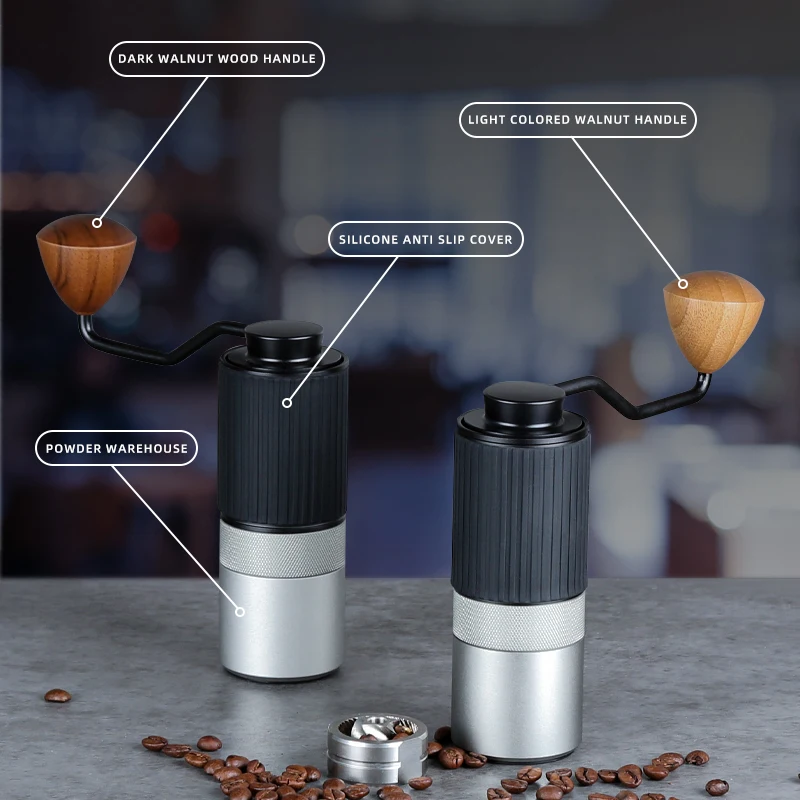
How Do Different Bean Origins and Roasts Affect Grinding for Manual Espresso?
Coffee beans vary dramatically in density, hardness, and brittleness based on their origin, variety, and roast level—all factors that directly impact how they should be ground for espresso.
Bean Origin Effects:
– High-altitude beans (often from Ethiopia, Kenya, or Colombia) tend to be denser and harder, requiring slightly finer grind settings
– Lower-altitude beans (like some Brazilians or Indonesians) may be softer, needing coarser settings to prevent over-extraction
Roast Level Considerations:
– Light roasts maintain more of the bean’s natural density and hardness, requiring finer grind settings and often more aggressive extraction parameters
– Medium roasts represent the “standard” for most espresso blends and are the easiest to work with
– Dark roasts become brittle and porous, extracting more readily and typically requiring a slightly coarser grind to prevent bitterness
Bean Age Adjustments:
– Very fresh beans (1-7 days off roast) contain significant CO2 that can disrupt extraction, often requiring a slightly coarser grind
– Properly rested beans (7-21 days) reach peak stability for espresso
– Older beans (beyond 30 days) lose compounds that contribute to crema and body, sometimes needing a finer grind to compensate
When switching between significantly different beans, expect to adjust your grind setting. Document successful settings for beans you use regularly to create a personal reference guide.
Fine Adjustment Hand Grinder, Precision Manual Grinder, Travel Coffee Grinder
Price range: $185.11 through $494.63 Select options This product has multiple variants. The options may be chosen on the product pageHand Burr Grinder, Hand Crank Coffee Grinder, Manual Espresso Grinder, Portable Coffee Grinder
Price range: $262.72 through $300.22 Select options This product has multiple variants. The options may be chosen on the product pageHand Burr Grinder, Manual Coffee Grinder Stainless Steel, Precision Manual Grinder
Price range: $183.64 through $187.52 Select options This product has multiple variants. The options may be chosen on the product pageManual Coffee Grinder Stainless Steel, Manual Espresso Grinder, Travel Coffee Grinder
Price range: $276.22 through $276.39 Select options This product has multiple variants. The options may be chosen on the product pageHand Crank Coffee Grinder, Manual Coffee Grinder for Espresso, Manual Coffee Grinder Stainless Steel
$349.15 Select options This product has multiple variants. The options may be chosen on the product page
Can You Fix Common Taste Issues Through Grind Adjustment?
Grind adjustments can resolve many flavor issues, but identifying the specific problem is key to applying the right solution:
Sour vs. Acidic: Bright acidity is desirable (think citrus notes), while sourness indicates under-extraction. If your espresso tastes sharply sour rather than pleasantly bright, try a finer grind to extract more sweet compounds that balance the acids.
Bitter vs. Rich: Chocolate-like bitterness can be pleasant, but harsh, aspirin-like bitterness suggests over-extraction. If your espresso leaves a lingering, unpleasant bitterness, adjust to a slightly coarser grind.
Thin Mouthfeel: When espresso lacks body and feels watery, it’s typically under-extracted. A finer grind will help extract more of the oils and dissolved solids that create richness.
Heavy, Syrupy Texture: While some body is desirable, an overly thick, almost muddy texture often indicates over-extraction. A marginally coarser grind can help achieve balance.
Remember that espresso grind settings interact with other variables. Sometimes adjusting dose weight (amount of coffee used) or brew ratio (amount of water used) can be more effective than changing grind size alone.
Is Hand Grinding Always Inferior to Electric Grinding for Espresso?
The quality gap between manual and electric grinders has narrowed significantly in recent years. Today’s premium manual grinders can absolutely produce espresso-quality results comparable to electric grinders costing much more.
Where Manual Grinders Excel:
– Precision adjustments often surpass all but the most expensive electric models
– No heat generation during grinding preserves volatile compounds
– Direct feedback through the grinding process
– Portability for travel
– Lower cost for equivalent grind quality
– Longevity (fewer mechanical/electrical parts to fail)
Where Electric Grinders Excel:
– Consistency across multiple consecutive shots
– Reduced physical effort for daily use
– Higher capacity for entertaining or family use
– Time efficiency for busy mornings
For the home enthusiast, high-quality manual versus automatic grinder settings for espresso often come down to personal workflow preferences rather than quality limitations. Many experts actually prefer manual grinding for single-dose specialty beans, reserving electric grinders for daily driver coffees.
Why Does Grind Consistency Matter More Than Grind Size?
While finding the right grind size is important, achieving consistency within that size is even more crucial for espresso extraction. Here’s why:
Imagine your coffee bed as a filter with thousands of tiny channels. When particle sizes vary significantly, water naturally follows the path of least resistance, flowing faster through areas with larger particles while barely penetrating zones with finer particles. This uneven extraction produces an espresso that’s simultaneously under-extracted (sour) and over-extracted (bitter).
The problem becomes especially apparent with the presence of:
– Fines: Ultra-small particles that can clog flow and over-extract quickly
– Boulders: Oversized particles that remain under-extracted, contributing sour notes
You can visually assess grind consistency by:
– Spreading grounds on a dark surface
– Looking for obvious size variations
– Checking for excessive dust (indicating too many fines)
The quality of your grinder directly impacts consistency. Flat burr hand grinders tend to produce highly uniform particle size through their design and precision manufacturing. When selecting a grinder, prioritize consistency capabilities over features or aesthetics—it’s the foundation of great espresso.
At Savor Suite, we understand that the journey to perfect manual espresso starts with precision grinding. Our collection of hand grinders is specifically selected to help coffee enthusiasts achieve the consistent, fine grind that manual espresso makers demand—because we believe that grinding for perfection truly does happen one bean at a time.

